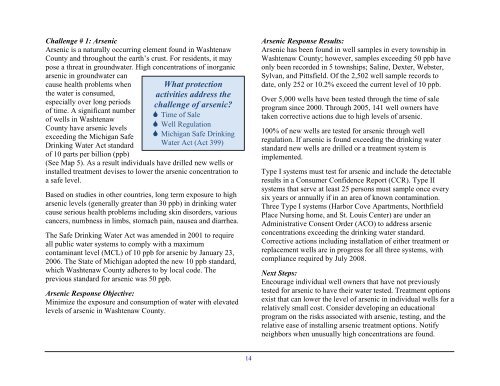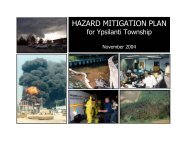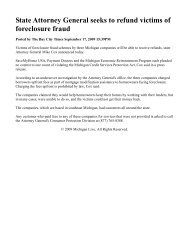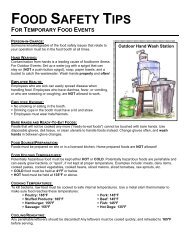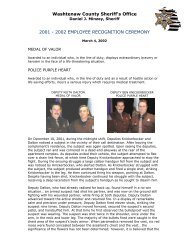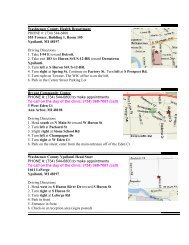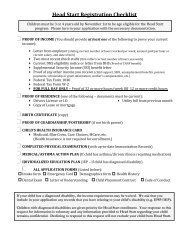Water Protection Activities in Washtenaw County
Water Protection Activities in Washtenaw County
Water Protection Activities in Washtenaw County
Create successful ePaper yourself
Turn your PDF publications into a flip-book with our unique Google optimized e-Paper software.
Challenge # 1: Arsenic<br />
Arsenic is a naturally occurr<strong>in</strong>g element found <strong>in</strong> <strong>Washtenaw</strong><br />
<strong>County</strong> and throughout the earth’s crust. For residents, it may<br />
pose a threat <strong>in</strong> groundwater. High concentrations of <strong>in</strong>organic<br />
arsenic <strong>in</strong> groundwater can<br />
cause health problems when<br />
the water is consumed,<br />
especially over long periods<br />
of time. A significant number<br />
of wells <strong>in</strong> <strong>Washtenaw</strong><br />
<strong>County</strong> have arsenic levels<br />
exceed<strong>in</strong>g the Michigan Safe<br />
Dr<strong>in</strong>k<strong>in</strong>g <strong>Water</strong> Act standard<br />
of 10 parts per billion (ppb)<br />
What protection<br />
activities address the<br />
challenge of arsenic?<br />
Time of Sale<br />
Well Regulation<br />
Michigan Safe Dr<strong>in</strong>k<strong>in</strong>g<br />
<strong>Water</strong> Act (Act 399)<br />
(See Map 5). As a result <strong>in</strong>dividuals have drilled new wells or<br />
<strong>in</strong>stalled treatment devises to lower the arsenic concentration to<br />
a safe level.<br />
Based on studies <strong>in</strong> other countries, long term exposure to high<br />
arsenic levels (generally greater than 30 ppb) <strong>in</strong> dr<strong>in</strong>k<strong>in</strong>g water<br />
cause serious health problems <strong>in</strong>clud<strong>in</strong>g sk<strong>in</strong> disorders, various<br />
cancers, numbness <strong>in</strong> limbs, stomach pa<strong>in</strong>, nausea and diarrhea.<br />
The Safe Dr<strong>in</strong>k<strong>in</strong>g <strong>Water</strong> Act was amended <strong>in</strong> 2001 to require<br />
all public water systems to comply with a maximum<br />
contam<strong>in</strong>ant level (MCL) of 10 ppb for arsenic by January 23,<br />
2006. The State of Michigan adopted the new 10 ppb standard,<br />
which <strong>Washtenaw</strong> <strong>County</strong> adheres to by local code. The<br />
previous standard for arsenic was 50 ppb.<br />
Arsenic Response Objective:<br />
M<strong>in</strong>imize the exposure and consumption of water with elevated<br />
levels of arsenic <strong>in</strong> <strong>Washtenaw</strong> <strong>County</strong>.<br />
14<br />
Arsenic Response Results:<br />
Arsenic has been found <strong>in</strong> well samples <strong>in</strong> every township <strong>in</strong><br />
<strong>Washtenaw</strong> <strong>County</strong>; however, samples exceed<strong>in</strong>g 50 ppb have<br />
only been recorded <strong>in</strong> 5 townships; Sal<strong>in</strong>e, Dexter, Webster,<br />
Sylvan, and Pittsfield. Of the 2,502 well sample records to<br />
date, only 252 or 10.2% exceed the current level of 10 ppb.<br />
Over 5,000 wells have been tested through the time of sale<br />
program s<strong>in</strong>ce 2000. Through 2005, 141 well owners have<br />
taken corrective actions due to high levels of arsenic.<br />
100% of new wells are tested for arsenic through well<br />
regulation. If arsenic is found exceed<strong>in</strong>g the dr<strong>in</strong>k<strong>in</strong>g water<br />
standard new wells are drilled or a treatment system is<br />
implemented.<br />
Type I systems must test for arsenic and <strong>in</strong>clude the detectable<br />
results <strong>in</strong> a Consumer Confidence Report (CCR). Type II<br />
systems that serve at least 25 persons must sample once every<br />
six years or annually if <strong>in</strong> an area of known contam<strong>in</strong>ation.<br />
Three Type I systems (Harbor Cove Apartments, Northfield<br />
Place Nurs<strong>in</strong>g home, and St. Louis Center) are under an<br />
Adm<strong>in</strong>istrative Consent Order (ACO) to address arsenic<br />
concentrations exceed<strong>in</strong>g the dr<strong>in</strong>k<strong>in</strong>g water standard.<br />
Corrective actions <strong>in</strong>clud<strong>in</strong>g <strong>in</strong>stallation of either treatment or<br />
replacement wells are <strong>in</strong> progress for all three systems, with<br />
compliance required by July 2008.<br />
Next Steps:<br />
Encourage <strong>in</strong>dividual well owners that have not previously<br />
tested for arsenic to have their water tested. Treatment options<br />
exist that can lower the level of arsenic <strong>in</strong> <strong>in</strong>dividual wells for a<br />
relatively small cost. Consider develop<strong>in</strong>g an educational<br />
program on the risks associated with arsenic, test<strong>in</strong>g, and the<br />
relative ease of <strong>in</strong>stall<strong>in</strong>g arsenic treatment options. Notify<br />
neighbors when unusually high concentrations are found.


